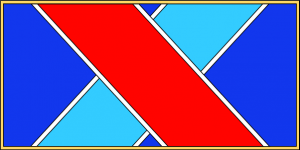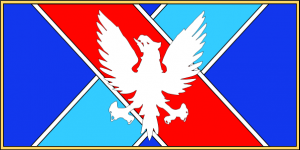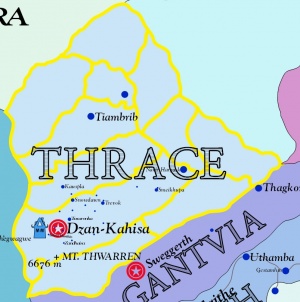Thrace
Thrace is an inland commonwealth located on the high plains and foothills east of the Jaggudorns and the Amandal Plateau. Thrace is bounded on the east and the south by the Jaggudorn Mountains and extends over a gradually lowering plateau to the Shadew River. Thrace has very cold winters and mild summers. The historic capital is Dzan Kahisa which is located in the foothills of the Jaggudorns. The highest point is Mount Thwarren (41.48 DF or 6676m or 21903 ft) which is considered sacred to the god Thwar. The name Thrace is derived from the Thracian word, Tuvarshekha or 'land of the god Thwar.'
In ancient times, Thrace became the homeland of the nomadic Thwarrish Gwenyan Tribes and is regarded as the ancestral homeland of all the first Gwenyan skyfaring tribes. Historically, Thrace was the core territory of the First Kalikán Empire and the New Kalikán Empire. Thrace underwent great changes in the twenty sixth century as she changed into a world power and then was reduced in power and revolution by the events of the Great Sky War.
Demography
Most inhabitants of Thrace are of Gwenyan Thracian stock and speak the Thracian Language. Minority humans include remnants of the Jamyá of the High Shadevan Tribes. Children of Thracian aristocrats claim descent from the ancient Kalikán tribe which formerly was held in great esteem. The population of Thrace is about half as populous as the nations of the eastern Pallathantic.
Commonwealth of Thrace
Thrace today is a commonwealth, but before the past roughly century and a half, Thrace was a monarchy since the advent of the Gwenyan Tribes for the past nearly four thousand years. The Commonwealth of Thrace today is comprised of eleven great cantons represented in the Thracian Chamber of Deputies. Thrace borders Dakkal, Gantvia, Thworgania, and the Jaffgorn Giant Tribes.


Politics
Thrace holds important economic and political ties with the Aurician Empire and the Empire of Magdala. During the twenty seventh century, Thrace reverted to a monarchy contrary to treaty, but the monarchy was eventually toppled and the commonwealth restored. Today a small minority wishes to restore the monarchy, but their influence is very small and the power of the commonwealth well established.
Economy
Thrace is largely agricultural and a very important producer of wheat and gontha beef and exports its surplus food, particularly grain, to the nations of the eastern Pallathantic by means of the Grand Shadew Canal which has enabled Thrace to undergo an economic revival in the beginning of the present century. Thrace is also an important center of producing traditional skycraft for gontha herding which command high prices by collectors abroad. Thrace is one of the primary destinations for leisure mountain climbers.
Religion
The national divinity of Thrace is the god Thwar who was regarded as the Sky Father. The Old Religion is well represented in Thrace and there are very few Arathracians and Incarnandists compared to other nations of the Pallathantic. The remnants of the High Shadevan Tribes practice shamanistic cults which preceded the Gwenyan period.
Minorities
- High Shadevan Tribes
- Jaggudornish Halflings
Chronology of Thrace
- 2576 Reduction of Thrace, Abolition of Thracian Monarchy, Royal Family sent into exile, establishment of Confederation of Thrace
- 2613 Royalist Faction has coup and installs grandnephew of last king as monarch; attempts at union with other nations (Gantvia, Jamenth, Shaddego, etc.) are unsuccessful.
- 2619 Civil War, Republicans overthrow royal faction in power
- 2623 Establishment of the Commonwealth of Thrace
See Also
| This article is a stub. It requires further development by the creator. |
